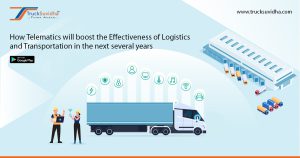How Telematics Will Boost the Effectiveness of Logistics and Transportation in the Next Several Years?
Businesses that run a fleet of vehicles benefit from telematics’ unique ability to understand both their drivers and vehicles.
- Telematics solutions give fleet managers vital information about their drivers and vehicles.
- Telematics provides a comprehensive view of a vehicle’s location and use when combined with GPS tracking.
- Fleet managers may design more effective routes and maintenance schedules and train drivers to drive more safely using the data collected by telematics.
In the transportation and trucking industries, telematics has become a crucial instrument. For more informed choices that boost the effectiveness of your fleet and company, combine telemetry systems and fleet management software. You need to comprehend what telematics systems are, how they operate, and their advantages if you want to make the most of your fleet of vehicles.
What are telematics systems?
Telematics entails transmitting data across considerable distances remotely. Telecommunications (remote communication) and informatics are two scientific fields that get combined in this project (the practise of information processing).
GPS technology, sensors, and onboard diagnostic codes are mainly used in telematics systems, sometimes referred to as fleet telematics, to gather data. This information consists of real-time engine diagnostics, car location, driving style, and vehicle activities. The following elements are typically found in telematics systems:
- Fleet communication software system
- GPS tracking device
- Engine interface
- Input/output interface
- SIM card
- Accelerometer
- Buzzer
GPS tracking vs.Telematics
The heart of the telematics system is GPS tracking. Each car’s dashboard has a GPS receiver, which resembles a black box, fitted underneath it to gather information about the location and condition of the car in real time. The central server of the fleet management system receives the GPS tracker data from the telematics system via a cellular network. The data get processed by the server, who also makes it available to other computers on the network as useable information.
How do telematics devices operate?\
A GPS tracking device in a car that is basically used by a telematics system to send, receive, and store telemetry data. A SIM card that connects the device to the onboard diagnostics (OBD-II) port or CAN bus port. Also, it connects to the company’s main server via a wireless network via an onboard modem.
The telematics system gathers GPS and vehicle-specific information, which it then communicates to the central server through a variety of channels (cellular network, satellite communication, 4G mobile data, and General Packet Radio Service). The server analyses the data, and end users can access a secure website or mobile app to examine the findings.
The telematics system collects this and other information about the vehicle:
- Location
- Usage
- Maintenance issues
- Fuel consumption
- Idling time
- Instances of harsh driving
- Speed and rapid acceleration
You may build reports on particular drivers and cars as well as the full fleet by analysing the data for specific occurrences and patterns.

What are the advantages of fleet telematics?
Telematics provides numerous advantages to firms that maintain a fleet of cars.
- It boosts productivity and efficiency.
Telematics employs GPS tracking to track the whereabouts of a vehicle in real time. You may utilise the data it generates to design safer and more efficient routes for drivers, reducing delivery times and fuel consumption. Geofencing can be also used to track and analyse driver performance versus delivery timetables, reducing driver detention time.
- It lowers gasoline and operational costs.
Telematics can help to plan smarter routes, which can minimise fuel use and other costs. You can, for example, use the programme to monitor and reduce vehicle idling. You can immediately tell who has to improve in this area by comparing the idle time of different drivers and cars. Lowering idle time lowers fuel expenditures, which are the main expense for a fleet.
- It automates payroll administration.
Telematics gives precise data on how far and how long certain vehicles have gone. You can use this to automate personnel records and payroll processing. This reduces the amount of manual administrative and clerical work necessary and lessens the possibility of errors.
- It improves driver safety.
Accidents involving motor vehicles are harmful for business as well as for drivers’ health and safety. Telematics can improve driver behaviour and promote overall road safety. Fleet management software may collect telemetry data on your team’s driving habits and rank your drivers according to their safety score. You may then teach your drivers on safer driving habits and improve the overall safety of your fleet.
Summary
The future will get characterised by how successfully logistics can focus on putting innovations onto their existing systems. To satisfy the increasing expectations of supplying goods in a tailored and purposeful manner, evolution will occur from compartmentalised reactive operations to forethoughtful thinking. Increasing connectivity will encourage logistics companies to collaborate across the ecosystem, making cross-border collaboration the new normal. Hence, rather of becoming cheaper and more efficient, telematics and logistics will become smarter and individualised.
Visit www.trucksuvidha.com for more details.




Recent Comments